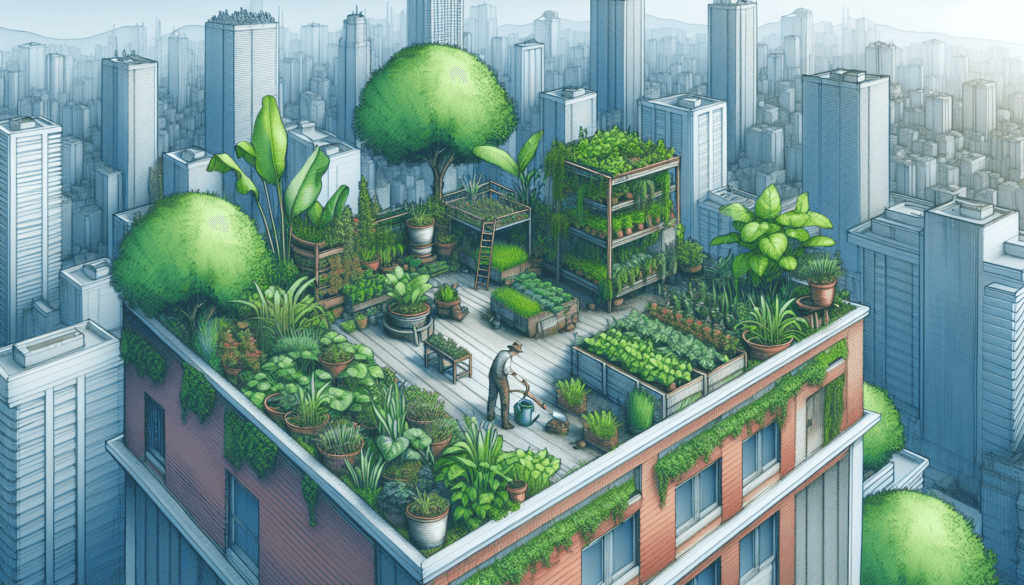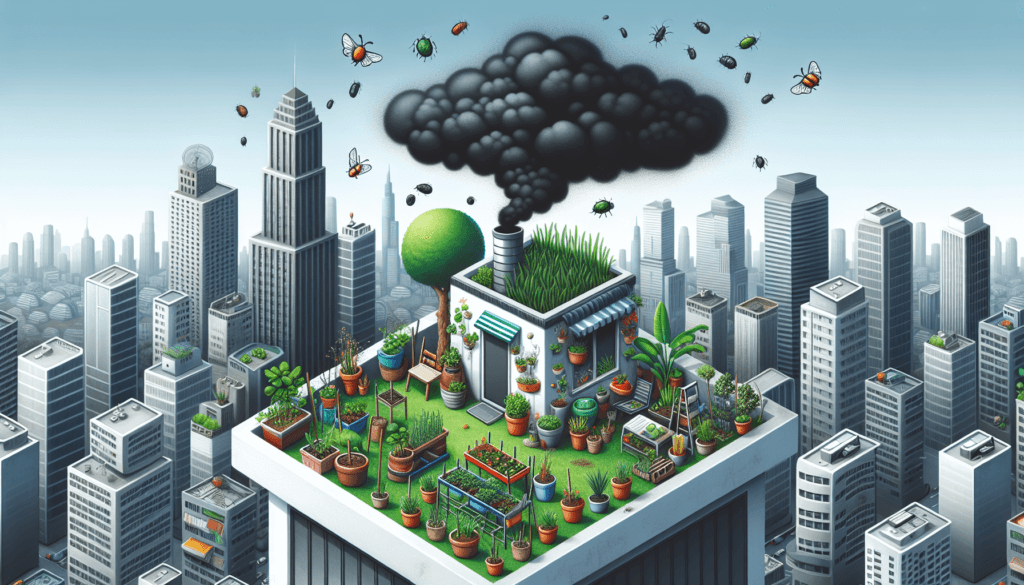Urban gardening has been gaining popularity lately as people seek to connect with nature and grow their own fresh produce. However, it’s important to be aware of the potential risks that come with this trendy hobby. From contaminated soil to pollutants in the air, urban gardening may pose some challenges that need to be addressed. In this article, we will explore these risks and provide tips on how to minimize them, so you can enjoy the benefits of urban gardening without worry. Urban gardening has become a popular trend in recent years, allowing individuals to cultivate their own plants and vegetables in urban areas. While it offers numerous benefits such as access to fresh produce and a connection to nature, it is essential to be aware of the potential risks associated with this activity. In this article, we will explore the various risks of urban gardening, including health risks, environmental risks, food safety risks, legal risks, infrastructure risks, community risks, maintenance risks, accessibility risks, weather and climate risks, and ethical risks. By understanding these risks, you can take the necessary precautions to ensure a safe and enjoyable urban gardening experience.
Health Risks
Exposure to Contaminated Soil: One of the primary concerns of urban gardening is the potential exposure to contaminated soil. Urban areas might have a history of industrial activities, leading to heavy metal and chemical pollutants present in the soil. These contaminants can be absorbed by plants and pose a risk to human health if consumed. It is crucial to test the soil before gardening and take appropriate measures to mitigate any contamination.
Air Pollution: Another health risk associated with urban gardening is air pollution. Urban areas often have higher levels of air pollutants due to traffic, industrial activities, and emissions from buildings. These pollutants can affect the quality of the plants grown in urban gardens. It is essential to monitor air quality and consider air filtration systems to minimize the impact of pollution on your garden.
Pesticide Exposure: The use of pesticides in urban gardening can also pose health risks. While pesticides are often necessary to manage pests and diseases, improper use or excessive application can lead to pesticide residues on crops. These residues can have adverse effects on human health if consumed. It is crucial to follow safe pesticide practices and consider using organic and natural alternatives to minimize exposure to harmful chemicals.
Allergic Reactions: For individuals with allergies, certain plants and flowers commonly found in urban gardens can trigger allergic reactions. Pollen from flowers can cause hay fever symptoms, while certain plants might release allergens that can irritate the skin or respiratory system. It is important to be aware of your specific allergies and choose plant varieties that are less likely to cause allergic reactions.
Injury Risks: Urban gardening involves physical labor and the use of gardening tools, which can increase the risk of injuries. Accidents such as cuts, sprains, or back strains can occur if proper safety precautions are not taken. It is crucial to use appropriate protective gear, handle tools responsibly, and practice proper lifting techniques to minimize the risk of injuries.
Environmental Risks
Soil Contamination: Urban areas often have a history of industrial activities, leading to soil contamination. This contamination can be caused by heavy metals, chemicals, or other hazardous substances, which can adversely affect the environment. To mitigate the risk of soil contamination, it is important to test the soil before gardening and take appropriate measures to remediate any contamination.
Water Pollution: Urban gardening practices such as the use of synthetic fertilizers or improper disposal of garden waste can contribute to water pollution. When it rains, these pollutants can be washed into nearby water bodies, thereby harming aquatic ecosystems. To minimize water pollution, it is important to use organic and natural fertilizers, dispose of garden waste properly, and avoid overwatering.
Harm to Local Ecosystem: Urban gardens can have unintended consequences on local ecosystems. Introducing non-native plant species or using excessive amounts of fertilizers and pesticides can disrupt the balance of local flora and fauna. This can lead to a decrease in biodiversity and negatively impact the surrounding environment. It is important to choose native plant species and use environmentally-friendly gardening practices to minimize harm to the local ecosystem.
Disruption of Natural Biodiversity: Urban gardens, if not planned and managed properly, can disrupt the natural biodiversity of an area. Introducing non-native plant species or removing native plants can lead to a loss of habitat for local wildlife. It is important to consider the ecological impact of your garden and strive to create a balance between cultivated plants and native flora to preserve biodiversity.

Food Safety Risks
Contamination from Pollutants: Urban areas are often more susceptible to pollutants such as heavy metals, chemicals, or other toxic substances. These pollutants can find their way into the plants grown in urban gardens, leading to potential food contamination. Testing the soil and water for pollutants, as well as using organic and natural gardening practices, can help minimize the risk of food contamination.
Improper Use of Fertilizers: The improper use of fertilizers can also pose food safety risks. Overuse of synthetic fertilizers can result in the accumulation of nitrates or other harmful chemicals in plants, which can be detrimental to human health if consumed in large quantities. It is essential to follow proper fertilization guidelines and opt for organic fertilizers to ensure the safety of the produce.
Cross-Contamination: In urban gardening, there is a risk of cross-contamination between plants. This can happen when diseases or pests spread from one plant to another, potentially affecting the entire garden. Implementing proper sanitation practices, such as cleaning tools and regularly inspecting plants for signs of diseases or pests, can help prevent cross-contamination and protect the health of your garden.
Lack of Regulation and Oversight: Unlike commercial agricultural practices, urban gardening often lacks the same level of regulation and oversight. This can lead to uncertainties regarding the safety of the produce. It is important to stay informed about local regulations and best practices for urban gardening to ensure that you are following appropriate guidelines for food safety.
Legal Risks
Zoning and Land Use Regulations: Urban gardening activities may be subject to zoning and land use regulations imposed by local authorities. These regulations dictate where and how gardening can take place within urban areas. It is important to familiarize yourself with the zoning regulations in your area to ensure that your gardening activities comply with the law.
Property Damage: Urban gardening, particularly in shared spaces or community gardens, can sometimes result in property damage. Accidental damage to structures, landscaping, or neighboring properties can occur during gardening activities. It is important to take precautions to prevent property damage and communicate with neighbors or garden organizers to address any concerns promptly.
Liability for Accidents: Engaging in urban gardening comes with a degree of risk, and there is a possibility of accidents occurring on your property or in shared gardening spaces. If someone gets injured while participating in gardening activities, you may be held liable for their injuries. It is advisable to maintain a safe environment, provide clear guidelines, and consider obtaining appropriate liability insurance coverage to protect yourself from potential legal issues.
Noncompliance with Local Laws: Failure to comply with local laws and regulations related to urban gardening can lead to legal consequences. This may include fines, citations, or even the closure of your garden. It is important to stay informed about local laws and regulations and ensure that you are in compliance to avoid legal risks.

Infrastructure Risks
Structural Damage: Urban gardening can sometimes pose risks to the structures on which gardens are built. The additional weight of soil, plants, and containers can strain structures, such as rooftops or balconies, leading to potential structural damage. It is crucial to seek professional advice and ensure that the structures are capable of supporting the weight of the garden before initiating urban gardening projects.
Sewer System Overload: Improper watering or drainage practices in urban gardens can overload the local sewer system. Excessive water from gardens can overwhelm stormwater infrastructure, leading to flooding or sewage backups. It is important to manage water usage and implement proper drainage systems to prevent sewer system overload and minimize the risk of damage to your property and the surrounding area.
Root Invasion: The roots of plants in urban gardens can potentially invade underground infrastructure, such as pipes, utility lines, or foundations. This can cause damage to essential infrastructure and lead to costly repairs. It is important to understand the root systems of the plants you are growing and take precautions, such as using root barriers or planting at a safe distance from infrastructure, to avoid root invasion.
Pest Infestations: Urban gardens can attract pests such as insects, rodents, or birds. While some pests are beneficial for pollination, others can cause damage to plants or spread diseases. Proper pest management practices, such as regular inspections, identifying and addressing pest problems promptly, and using natural pest control methods, can help prevent infestations and protect your garden and surrounding areas.
Community Risks
Conflicts with Neighbors: Engaging in urban gardening activities can sometimes result in conflicts with neighbors. Issues such as noise, odors, property boundaries, or disagreements over shared gardening spaces can arise. It is important to maintain open communication with neighbors, address concerns promptly, and establish clear guidelines to prevent conflicts and maintain positive relationships within the community.
Decreased Property Values: Depending on the location, the presence of an urban garden in a neighborhood may potentially impact property values. While well-maintained and aesthetically pleasing gardens can enhance property values, neglected or poorly maintained gardens can have the opposite effect. It is important to ensure that your garden contributes positively to the neighborhood and is well-maintained to minimize any negative impact on property values.
Lack of Space for Other Uses: Utilizing urban space for gardening purposes can sometimes limit the availability of space for other community activities or amenities. In densely populated areas, the demand for various uses of space can be high, and conflicts may arise over the allocation of limited space for gardening purposes. It is necessary to consider the overall needs of the community and work collaboratively to find a balance between gardening and other uses of space.
Unintended Consequences on Neighborhood Dynamics: Urban gardening initiatives can have unintended consequences on neighborhood dynamics. For example, community gardens may unintentionally exclude certain individuals or groups due to various barriers like language or cultural differences, leading to social stratification. It is essential to promote inclusive gardening initiatives, embrace diversity, and ensure that opportunities for gardening are accessible to all members of the community.

Maintenance Risks
Time Commitment: Urban gardening requires consistent maintenance to ensure the health and productivity of plants. Depending on the size of the garden, the time commitment required can vary. It is important to consider the amount of time you can dedicate to garden maintenance and plan accordingly. If you have limited time, opting for low-maintenance plants or involving others in communal gardening efforts can help distribute the workload.
Skill and Knowledge Requirements: Successful urban gardening often requires knowledge and skills related to plant care, pest management, soil fertility, and gardening techniques. Lack of understanding or experience in these areas can lead to suboptimal results or plant health issues. It is essential to educate yourself about gardening practices, seek guidance from experienced gardeners, and continually learn and improve your gardening skills.
Plant Diseases and Pests: Urban gardens, like any other garden, can be susceptible to plant diseases and pests. Fungal infections, insect infestations, or the emergence of invasive species can pose challenges to maintaining healthy plants. Regular monitoring, proper sanitation practices, and early intervention are key to preventing the spread of diseases and pests and preserving the overall health of your garden.
Weed Control: Weed management is an integral part of maintaining an urban garden. Weeds can compete with cultivated plants for resources such as water, nutrients, and sunlight, potentially impacting plant growth and productivity. Implementing effective weed control strategies, such as mulching, hand weeding, or using natural weed suppressants, can help minimize weed growth and ensure the success of your garden.
Accessibility Risks
Social and Economic Barriers: Urban gardening initiatives may inadvertently exclude certain individuals or communities due to social or economic barriers. Factors such as limited financial resources or lack of access to gardening spaces can create inequalities in accessing gardening opportunities. It is important to promote equitable access to urban gardening by providing affordable or subsidized gardening resources and supporting community initiatives that aim to overcome social and economic barriers.
Physical Accessibility: Urban gardening spaces should be designed to ensure physical accessibility for individuals with disabilities or limited mobility. Accessible pathways, raised garden beds, or adaptive gardening tools can help create an inclusive environment that allows everyone to participate in gardening activities. Consideration should also be given to the placement of garden features to ensure easy access for all members of the community.
Spatial Constraints: Urban areas often have limited space available for gardening, making it challenging to accommodate the needs and desires of all individuals. Lack of space can restrict the scale of gardening activities or limit the variety of plants that can be grown. It is important to optimize the available space and explore creative ways to maximize gardening opportunities within the constraints of urban environments.
Limited Availability of Resources: Accessing gardening resources such as affordable seeds, plants, tools, or educational materials can be more challenging in urban areas compared to rural areas. Limited availability of resources can hinder the success of urban gardening initiatives. Supporting local nurseries, seed libraries, or community organizations that provide gardening resources can help address this issue and ensure that resources are accessible to urban gardeners.

Weather and Climate Risks
Extreme Temperature Variation: Urban areas often experience more pronounced temperature variations compared to rural areas due to the urban heat island effect. Extreme heat or cold can stress plants, affect their growth, or even cause them to perish. It is important to choose plant varieties that are suitable for the local climate and take measures to protect plants from extreme temperatures, such as providing shade or using season-extending techniques.
Drought and Water Scarcity: Urban areas may face challenges related to water scarcity or drought, especially during dry seasons or in regions with limited water resources. Watering restrictions or high water bills can make it difficult to maintain a thriving garden. Implementing water-saving techniques, such as collecting and reusing rainwater or using efficient irrigation methods, can help mitigate the impact of water scarcity on your garden.
Heavy Rainfall and Flooding: Urban areas can be prone to intense rainfall and localized flooding, which can have detrimental effects on gardens. Excessive water can lead to waterlogging, soil erosion, or damage to plants. Proper drainage systems, raised garden beds, or selecting plants that can tolerate wet conditions can help minimize the risk of damage due to heavy rainfall or flooding.
Climate Change Impacts: Climate change can have long-term implications for urban gardening. Changing weather patterns, more frequent extreme weather events, or shifts in growing seasons can pose challenges to gardening practices. It is important to adapt gardening techniques, choose resilient plant varieties, and stay informed about climate change projections to ensure the long-term sustainability and success of your urban garden.
Ethical Risks
Gentrification and Displacement: Urban gardening initiatives can sometimes contribute to gentrification processes, leading to the displacement of marginalized communities. When gentrification occurs, property values increase, making it more difficult for lower-income residents to afford housing in the area. It is crucial to consider the potential impact of gardening initiatives on the local community and work towards inclusive and equitable urban development.
Cultural Appropriation: Engaging in urban gardening practices must be done with respect for cultural heritage and practices. Adopting gardening techniques or introducing traditional crops from specific cultural backgrounds without proper understanding or acknowledgment can be seen as cultural appropriation. It is important to approach urban gardening with cultural sensitivity, engage in open dialogue, and learn from diverse perspectives to avoid cultural appropriation and encourage cultural exchange.
Equitable Access to Gardening Opportunities: Urban gardening initiatives should strive to provide equitable access to gardening opportunities for all members of the community. Ensuring that resources, spaces, and knowledge are accessible to individuals from diverse backgrounds can contribute to community cohesion and empowerment. Collaborating with community organizations, offering gardening education programs, and promoting inclusive gardening spaces can help foster equitable access to gardening opportunities.
Potential Exploitation of Labor: Urban gardening initiatives that rely on community involvement or volunteer labor should be mindful of potential labor exploitation. Unpaid or undercompensated labor can perpetuate inequities and exploit individuals, particularly those from marginalized communities. It is important to ensure that fair labor practices are implemented, provide appropriate compensation or benefits, and consider the well-being of those involved in gardening initiatives.
In conclusion, urban gardening offers numerous benefits but also poses various risks that need to be considered. Health risks, environmental risks, food safety risks, legal risks, infrastructure risks, community risks, maintenance risks, accessibility risks, weather and climate risks, and ethical risks all require attention when engaging in urban gardening. By understanding and addressing these risks, it is possible to create safe, sustainable, and inclusive urban gardening environments that benefit individuals, communities, and the environment.



